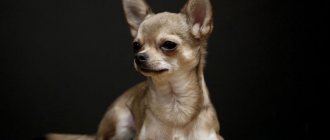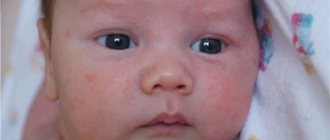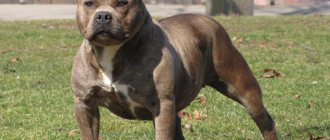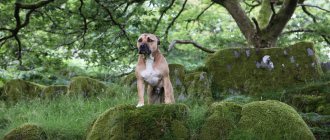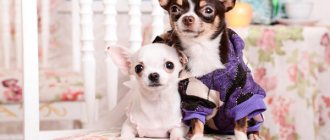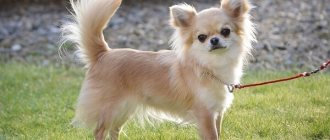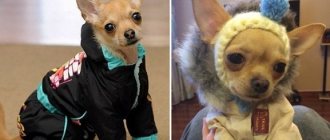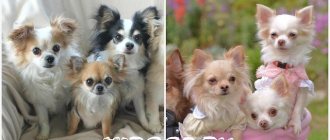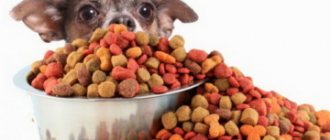The standard for the decorative Chihuahua dog breed defines a whole range of characteristics that a small dog should have. They establish the general type of Chihuahua, characteristics of the head, proportions, facial area, limbs, body, color of this breed of small dogs, including disqualifying defects. More details about the official characteristics and standards of the Chihuahua, which are regulated by the FCI document, can be found in our article about the standards of the Chihuahua breed. You can talk about the types of Chihuahuas. Which types of such small dogs are officially recognized by standards and breeders, and which types were specially invented by dishonest sellers in order to sell puppies that do not meet basic requirements at a higher price?
Currently, based on the structure of the body, two types of Chihuahua dogs are recognized by standards: the Deer type and the Cobby type. Let's take a closer look at them.
History of the breed
When Chihuahuas appeared, there was no single breed type. Dogs could be of any color and build, and there were also differences in their sizes.
But at the same time, high-legged dogs had advantages - it was easier for them to hunt small animals living in the jungles of Mesoamerica, where their ancestors appeared in the 15th century BC.
Perhaps it was this feature that helped the long-legged and fast dogs of this breed survive difficult times, when, after the conquest of Mexico by the conquistadors, they again went wild and lived in the forests. When they were domesticated again by local residents, these small, graceful dogs became faithful and devoted companions for them.
In the middle of the 19th century, American travelers became interested in Chihuahuas and local residents began selling them puppies of this breed.
Read more about the history of the Chihuahua here.
NOTE!
Most of the first Chihuahuas brought to the United States from Mexico were more similar to the modern Deer type of dog.
Long-legged, deer-like dogs were popular until relatively recently, when stocky Cobby-type Chihuahuas began to be considered more conformable.
What dog experts say
We have described the standard types and types into which Chihuahua dogs can be divided. In addition, there are many nuances that will help you not make a mistake in choosing a pet and buy exactly the dog that you originally wanted.
Firstly, it is worth considering the fact that there are a lot of unscrupulous breeders. There are breeds that are not recognized by the standard, but they are often passed off as the standard type of Chihuahua. These, for example, include the Pekingese, Aboriginal, English, Extreme, and Exotic types. All these breeds are not recognized by the standard and are considered defective. And it’s not surprising, because many of the above breeds could have been bred only to see what would happen if the dog had non-standard proportions.
Related article: How to train a Chihuahua to a diaper or litter box
For example, an extreme type Chihuahua has really extremely short legs, on which it cannot even walk properly. Thus, all these types are not included in the standard, and life is very difficult for animals of such breeds. Of course, you can buy such a dog, but it will require special care, and you definitely won’t be able to send it to an exhibition.
Secondly, if you want to buy a pet to participate in exhibitions, it is recommended to choose a cobby type. Although, according to dog experts, this type is rarely seen in its pure form now, so if you want to assess the prospects, look at the baby’s parents and evaluate their successes at exhibitions.
The last thing worth saying is that you should not opt for a low price. Of course, it is not a fact that if you buy a dog for a lot of money, this acquisition will be successful, but the likelihood of becoming the owner of a sick puppy by purchasing it for a low price is extremely high. Therefore, carefully check from whom and for what amount you will purchase a pet. And if you decide to buy a dog with health problems, make sure you know exactly what’s wrong with it and how it can be cured (and whether it can be).
Description of character
The Chihuahua Deer is a small, elegantly built dog. She looks elegant and sophisticated, and her movements are light and free. When such a dog runs, it seems that it almost does not touch the ground.
Chihuahua Deer are smart and very understanding. These are active and playful dogs that, despite their apparent fragility, are resilient and quite strong.
They are selflessly devoted to their owner, friendly and affectionate towards him. But they are wary of strangers.
Chihuahua Deer make good guards. Despite their small size, they are always ready to protect their owner or his property.
Distinctive features
Distinctive features of dogs of this type are:
- the head is relatively small in size, slightly elongated in shape;
- elongated muzzle;
- large and high-set ears;
- deep, but not wide chest;
- rather long paws;
- long and thin tail;
- the angles of the articulations are less pronounced than those of the cobby;
- There is no sense of strength or power in the movements of Deer type dogs.
Deer-type Chihuahuas do not have well-developed muscles, which makes them visually more sophisticated than representatives of the Cobby type.
Type of chihuahua dir
These Chihuahuas are also called deer-like Chihuahuas because they are, in fact, very similar to a fawn. They are characterized by a small head with large ears and an elongated muzzle, which give the dog a bat-like appearance. The chest has a smaller volume than that of Cobby dogs. The paws of this variety are thinner and narrower, the angles of the hock joints are less pronounced.
The tail is much thinner and longer than that of the cobe, and the strides are smaller due to the fact that the propulsion of the hind legs is clearly weaker. The coat is not so thick, with virtually no undercoat. Both types are recognized by breeders, but preference is given to the Cobby type. According to the type of coat, Chihuahuas can be long-haired or smooth-haired. The smooth-haired variety has thick hair that fits tightly to the body.
This fur shines beautifully like silk. Long-haired dogs have undercoat, visible on the neck with a collar, on the ears with a fringe and tail. completely covered with fur. The surface of this coat is smooth and slightly wavy. Unofficial or false types of Chihuahuas
What other types of Chihuahuas are there?
Many sellers talk about a much larger number of types of Chihuahuas, including classic, aboriginal, extreme, English, exotic. But these are the so-called false types. “Native” Chihuahuas are exported from the ancestral country of this breed - Mexico.
These dogs have a sharp muzzle, an insufficiently round head with close-set eyes and ears. At the same time, the dog has a fairly large body weight, which does not fit into the breed standard, and a large tail, curled around the back of the Chihuahua. The “English” Chihuahua has a rather massive build with a rough bone structure and, as a result, a lot of weight.
The “extreme” Chihuahua is characterized by a peculiar excess. His doll head looks too artificial, his eyes are too bulging, and his limbs are too thin. These are real dwarfs. The “exotic” Chihuahua is similar to the “extreme” one, but is even smaller in size. The “classic” Chihuahua is similar to the Dire type, but differs in a simplified skull shape with a muzzle that is too long. He also has the wrong angle of his feet.
Did you like it? Share with your friends!
Accepted standard type dir
The size of a standard Chihuahua Deer should be no more than 23 cm at the withers. Weight ranges from 0.5 to 3 kg.
The Chihuahua Deer is a small, square dog with a light bone structure.
The head does not look large or convex. The transition to an elongated muzzle is pronounced, but not sharp.
The ears are large and rather thin. They are set high, which gives the dog a resemblance to a fawn.
The eyes are relatively small, slightly convex. Their most preferred color is dark shades of brown.
The nose color is black or matches the base color.
The neck is quite long and narrow. The back is straight, not wide, merging into a slightly sloping croup.
The chest is deep enough, but not too voluminous. The stomach is tucked.
The limbs are parallel, due to the lack of pronounced muscles, they appear thin and long.
The tail is set quite high, long and thin.
The coat is soft, can be either smooth or quite long, but not fluttering.
According to the breed standard , all colors except merle are considered acceptable for Chihuahuas.
Expert opinion
Kozhevin Semyon Kirillovich
Expert dog handler.
Deer-type dogs are on the verge of the standard. Many Deer Chihuahuas look more like small greyhounds than their own breed. This dog is a representative of the classic breed type, which has existed for centuries and was incredibly popular back in the first half of the twentieth century. However, the exterior of such dogs should not have the excessive lightness of build and stylization inherent in many modern Chihuahua Dires.
Types by coat type
According to the official breed standard, Chihuahuas come in short-haired and long-haired varieties. All other options are considered a defect and deviation from the standard.
Smooth-haired
These dogs have a short, smooth, fleecy and thick coat that fits tightly to the body. The guard hair is soft and silky, but stiffer than that of long-haired individuals. The undercoat is poorly developed or completely absent. The hairs on the tail and around the neck may be slightly longer, but the hair under the throat is thinner. Smooth-haired Chihuahuas need to be brushed weekly with a special rubber glove or a massage brush with soft natural bristles.
Longhair
These Chihuahuas have quite long, thin and soft hair. It is preferable for the hairs to be straight, but the standard allows for slight waviness. Curly hair is considered a serious defect. The undercoat can be developed, thick and fluffy, or completely absent. The fur reaches its maximum length in the area of the ears, belly, tail and back of the limbs, and forms feathering in the “collar” zone.
Long-haired representatives of the breed need to be brushed with a soft-bristled brush every 2 days, and during shedding - daily, using a slicker brush. These Chihuahuas also need to be groomed regularly. Haircuts can be modeling (more often required for show animals) or hygienic, which consists of shortening the hair on the back, belly and sides, removing hair on the ears, paws and around the anus.
Shorthair
Such dogs belong to the so-called transitional type, i.e. their coat is shorter than that of long-haired representatives of the breed, but longer than that of smooth-haired dogs.
Transitional Chihuahuas cannot participate in exhibitions or breeding.
Bald
Chihuahuas that do not have fur are not the result of recent selection; such dogs have always existed. They look unusual and original - their beige or bluish-gray smooth skin without hair gives them a resemblance to elegant porcelain figurines. Hairless Chihuahuas, especially mini or super-mini, require the most careful care and monitoring of their health.
How is it different from a cobby?
The Deer differs from the Cobby-type Chihuahua in its greater grace and lightness of structure.
The head of the dir is less voluminous, and the muzzle is longer.
The position of the ears is also different - in the cobby they are low and relatively small in size, while in the dir the ears are large, thin and high-set.
Advantages and disadvantages
Pros:
- look sophisticated and elegant;
- sociable and playful;
- are distinguished by loyalty and love for their owners;
- They make sensitive watchmen;
- do not need a large living space;
- if you accustom your Chihuahua Dir to a tray or diaper, then you can forget about walks in inclement or too cold weather;
- do not require complex and time-consuming care;
- You can take such a dog with you on any trip;
- smart and trainable.
Minuses:
- You cannot buy such dogs for families with children;
- may be injured during a jump or fall;
- if not properly raised, they can show aggression even towards their owner;
- monogamous - they recognize only one owner in the family;
- can bully other people's dogs on the street;
- sometimes they are quite jealous;
- They don't like dogs of other breeds.
IMPORTANT!
When training a Chihuahua Dire, it is necessary to take into account that physical methods of influence cannot be used during training.
Basic rules of care
The coat of a smooth-haired dog should be combed with a brush two or three times a week, and during the shedding period - daily. It is recommended that long-haired Deer Chihuahuas be combed with a comb every day.
It is not necessary to bathe these dogs often, and it is better not to wash them at all unless necessary.
Your pet's ears and eyes should be examined every day in order to notice the first signs of inflammation in time. They only need to be cleaned if they become dirty. Nails should be trimmed with a nail clipper once every six months.
To clean teeth, your pet should be given chewing toys or treats designed to remove plaque.
Due to the fact that the deer has an accelerated metabolism, these dogs need warm clothes even in cool weather, and the pet must wear them indoors.
NOTE!
Chihuahua Dire is not intended for street keeping - such a dog should only live in a house or apartment.
How to choose a puppy?
Despite the fact that most modern breeders breed Cobby Chihuahuas, it is still quite possible to find Dire puppies with documents.
When choosing a future pet, you need to pay attention to the structure of its muzzle and head - while cobbies have a convex skull, dirs have an elongated one. The muzzles of this type of Chihuahua are quite long, the ears are larger and set high, and the eyes are not very large and less rounded than those of the Cobby, and this is noticeable already at an early age.
IMPORTANT!
The Chihuahua puppy should have a balanced psyche and should not have even the slightest signs of illness.
Who are cobbies?
“Cobby” got its name from the English word cobby - short, stocky. Cobby-type Chihuahuas are bony, their head is voluminous, apple-shaped, and their muzzle is full. The ears are wide at the base, quite large, but look harmonious.
The body is massive, the chest is deep and voluminous. The neck and limbs are powerful and shortened. Such animals move well, they have good angulations of the limbs, and a strong topline. The cobby's tail is also massive, thick at the base. The coat is thick, with a pronounced undercoat.
Typically, by offering cobby-type puppies, breeders want to make it clear that these are animals suitable for exhibitions and further breeding.
This photo shows an adult male Coby type: dense, tightly built, with a short neck.
